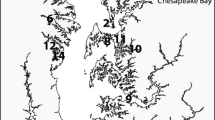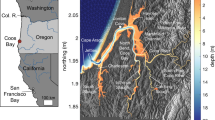Abstract
Data and theory show that the inlets of several large estuaries on Australia’s eastern seaboard that appeared to be stable within a range of entrance conditions are demonstrating unstable scouring modes and have been doing so for decades, if not centuries, since entrance jetties had been constructed. Jetties have increased the hydraulic conveyance of the entrance channels by removing sand bars and extraneous littoral currents that impeded ebb tide discharges. Field data comprising comprehensive water level monitoring in the bays, enabling the definition of tidal planes to a high resolution, have shown that the spring tidal ranges of these bays has been increasing steadily for decades with high tide planes rising and low tide planes falling. The field data have indicated that these changes show no signs of stabilizing and Escoffier analyses have indicated that it could take centuries for these inlets to reach new stable hydraulic regimes. Implications have included extensive scour in the entrance channels requiring channel erosion protection works, subsidence of road bridges, collapse of foreshores including buildings, sedimentation in the bays and on adjacent beaches and permanent changes to fringing marine ecologies and fisheries. Changes to the distribution of seagrass, saltmarsh and mangrove forests have been observed to coincide with and confirm the expectations of impacts on marine ecology that could derive from jetty construction. While jetties have improved flood conveyance significantly the increases in ebb tide velocities have resulted in navigational hazards for recreational boating.
Access this chapter
Tax calculation will be finalised at checkout
Purchases are for personal use only
Similar content being viewed by others
Notes
- 1.
The field data upon which the research herein was based was provided generously by the NSW Government Public Works Department Manly Hydraulics Laboratory. The authors take responsibility for its analysis and interpretation.
References
Brown EI (1928) Inlets on sandy coasts. ASCE Proc 54:505–553
Bruun P (1978) Design of tidal inlets on littoral drift shores. Coastal Sediments ‘77. Proceedings 5th Symposium of the Waterway, Port, Coastal and Ocean Division of ASCE, Charleston, pp 927–945
Burrell A (2012) Mapping changes of saltmarsh and mangrove vegetation communities in Wagonga Inlet, NSW South Coast Bachelor of Environmental Science (Honours), School of Earth & Environmental Science, University of Wollongong, 166pp
Czerniak MT (1978) Inlet interaction and stability theory verification. Coastal Sediments ‘77. Proceedings 5th Symposium of the Waterway, Port, Coastal and Ocean Division of ASCE, Charleston, pp 754–773
Dekker AG, Anstee JM, Brando VE (2003) Seagrass change assessment using satellite data for Wallis Lake, NSW. CSIRO Land and Water Technical Report 13/03 in pdf format at http://www.clw.csiro.au/publications/technical2003/
Duchatel K, Williams R, Gordon AD, Nielsen AF (2014) Unintended long term environmental disturbances from estuary entrance breakwaters. Proceedings Environment Institute of Australia & New Zealand Annual Conference, Hobart
Escoffier FF (1940) The stability of tidal inlets. Shore Beach 8(4):114–115
Gordon AD (1990) Coastal lagoon entrance dynamics. Proceedings 22nd Coastal Engineering Conference, ASCE, pp 2880–2893
Henderson FM (1966) Open channel flow, Macmillan, New York, 522pp
Jarrett JT (1976) Tidal prism – inlet area relationships. GITT Report 3, U.S. Army Coastal Engineering Research Centre, Ft Belvoir, 32pp
Kailola PJ (1993) Fisheries research and development corporation (Australia) & Australia Bureau of Resource Sciences, Australian fisheries resources. Bureau of Resource Sciences and the Fisheries Research and Development Corporation, Canberra, 422pp
Keulegan GH (1951) Tidal flow in entrances, water level fluctuations of basins in communication with seas. National Bureau of Standards Report No. 1146, 28pp
Keulegan GH (1967) Tidal flow in entrances water-level fluctuations of basins in communication with seas. Tech Bull 14, U S Army Corps of Engineers, 89pp
MHL (1994) NSW breakwaters – asset appraisal. Public Works Department State Projects Manly Hydraulics Laboratory Report MHL647, May
MHL (2001) Wagonga inlet processes study. NSW Dept. Public Works & Services, Manly Hydraulics Laboratory Report MHL1011, April
Mota Oliviera IB (1970) Natural flushing ability in tidal inlets. Proceedings 12th Coastal Engineering Conference, ASCE, pp 1827–1845
Nielsen AF, Gordon AD (1980) Tidal inlet behavioural analysis. Proceedings 17th Coastal Engineering Conference, ASCE, pp 2461–2480
Nielsen AF, Gordon AD (2008) The hydraulic stability of some large NSW estuaries. Aust J Civ Eng 5(1):49–59
Nielsen AF, Gordon AD (2011) The impact of entrance breakwaters on large estuaries. IAHR, Brisbane, June, 8 pp
Nielsen AF, Gordon AD (2015) The impact of entrance jetties on the hydraulics and ecologies of large estuaries. Shore Beach, 83, 3, Summer 2015, 43–58.
NSW MER (2007) Wetlands monitoring evaluation and reporting program. Assessing the extent and condition of wetlands in NSW. NSW Government Office of Environment and Heritage
O’Brien MP (1931) Estuary tidal prism related to entrance areas. Civ Eng 1(8):738
O’Brien MP (1969) Equilibrium flow areas of inlets on sandy coasts. ASCE Proc J Waterw Harb Div 95(WW1):43–52
O’Brien MP, Dean RG (1972) Hydraulics and sedimentary stability of coastal inlets. Proceedings 13th Coastal Engineering Conference, ASCE, pp 761–780
Pennington, J (1877) In: Oyster Culture Commission, 1877. Report of the Royal Commission, appointed on the 29th September, 1876 to inquire into the best mode of cultivating the oyster together with the minutes of evidence, and appendices. Charles Potter Acting Government Printer, Sydney, 57 pp. Appendix, p. 65
Seabergh WC (2003) Long-term coastal inlet channel area stability. Proceedings Coastal Sediments ‘03, CD-ROM, World Scientific & East Meets West Productions, Corpus Christie, 8pp
Seabergh WC, Kraus NC (1997) PC program for coastal inlet stability analysis using Escoffier method. CETN IV-11, US Army Corps of Engineering, Waterways Experiment Station, Coastal & Hydraulics Laboratory, December
Skou, A (1990) On the geometry of cross-section areas in tidal inlets, Series Paper No. 51, Institute of Hydrodynamics and Hydraulic Engineering, Technical University of Denmark, Lyngby
Van de Kreeke J (1992) Stability of tidal inlets; Escoffier analysis. Shore Beach 60(1):9–12
Watterson E (2010) Tidal modelling of Lake Macquarie. WorleyParsons Report 301020-02167 – 01 prepared for Lake Macquarie City Council, September, 125pp
West RJ, Thorogood CA, Walford TR, Williams RJ (1985) An estuarine inventory for NSW, Australia. Fisheries Bulletin 2, Department of Agriculture NSW
Williams RJ, West G, Morrison D, Creese B (2006) Estuarine Resources of New South Wales’. In: a 2-part DVD pack published by the NSW Department of Planning. Australia, Sydney. http://www.dpi.nsw.gov.au/content/research/areas/aquatic-ecosystems/outputs/2006/709
Author information
Authors and Affiliations
Corresponding author
Editor information
Editors and Affiliations
Rights and permissions
Copyright information
© 2017 Springer International Publishing AG
About this chapter
Cite this chapter
Nielsen, A.F., Gordon, A.D. (2017). Long Term Impacts of Jetties and Training Walls on Estuarine Hydraulics and Ecologies. In: Finkl, C., Makowski, C. (eds) Coastal Wetlands: Alteration and Remediation. Coastal Research Library, vol 21. Springer, Cham. https://doi.org/10.1007/978-3-319-56179-0_10
Download citation
DOI: https://doi.org/10.1007/978-3-319-56179-0_10
Published:
Publisher Name: Springer, Cham
Print ISBN: 978-3-319-56178-3
Online ISBN: 978-3-319-56179-0
eBook Packages: Earth and Environmental ScienceEarth and Environmental Science (R0)




